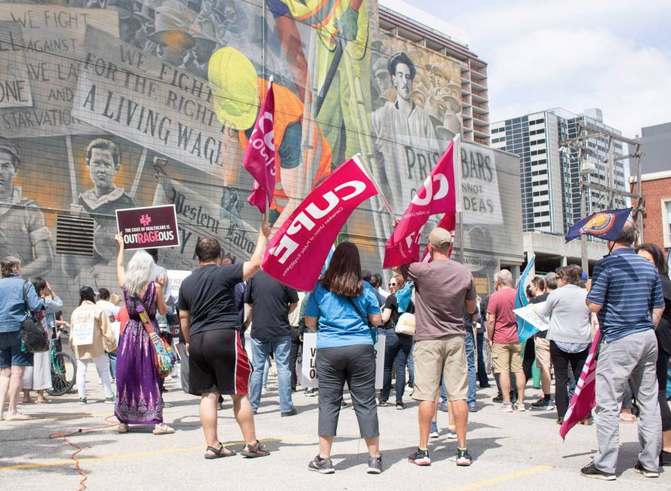Previously published in the Winnipeg Free Press July 15, 2023

By Katherine Burley, Robert Chernomas and Ian Hudson
On July 11 a rally to “Save Public Health Care” took place, timed to coincide with the meetings of the Canadian premiers in Winnipeg. While provinces across the country are facing health-care challenges, Manitoba’s system needs more saving than average.
The Manitoba government has prioritized parsimony over quality, applying its broad-based agenda of cost cutting and privatization to health care. In April 2017, Manitoba introduced a vision for overhauling the province’s health-care system, entitled Manitoba’s Health System Transformation. This multi-year project, intended to bolster health-care co-ordination and reduce costs, has involved cuts, closures, and massive restructuring. While this project was sold as a rationalization that would improve efficiency, it has demoralized the province’s health-care workers and has compromised the care they are able to provide.
On a real per capita basis, health-care expenditures rose 3.8 percent from 2011 to 2015, but fell by 3.5 percent between 2015 and 2019 (the pre-pandemic period). While Manitoba was consistently in the top four provinces for provincial spending on health care during the NDP’s reign, in the five PC years prior to the pandemic, it was consistently one of the lowest-spending provinces.
Since 2016, Manitobans have had to contend with cuts and reorganization in many harmful forms. Against the wishes of its doctors, the province privatized the Lifeflight air ambulance. A fatality on the privately run medical transport has resulted in a lawsuit against the province alleging that the cuts to the air service contributed to the death.
In February 2017, the province cancelled $1 billion worth of planned new health infrastructure projects, including a proposed new personal care home in Lac Du Bonnet. In April 2017, they closed the emergency rooms at Concordia, Victoria, and Seven Oaks Hospitals, and the urgent care centre at Misericordia Hospital, leaving only four emergency departments equipped to treat patients in potentially life-threatening situations in Winnipeg.
Staff have been further directly impacted by mass position deletions, relocations, and layoffs, including 500 WRHA nursing position deletions and 700 hospital support staff position deletions in August and September 2017. The Free Press reported that the province spent $60 million on contracted out agency nurses in the 2022-23 fiscal year.
The consequences of these cuts are that Manitoba fares worse than the Canadian average on a variety of health-care indicators, including wait times, physicians per 100,000 population, wages for health-care workers, and job vacancies. From 2015 to 2022, the job vacancy rate for health and social assistance workers rose both in Manitoba and in other provinces, but the gap between Manitoba and the Canadian average widened substantially.
In 2016, Manitoba’s job vacancy rate was only 0.3 percentage points higher than the Canadian average, but by 2020 it was 2.3 percentage points higher. Similarly, while Manitoba’s surgery wait times were longer than the Canadian average under the NDP, the situation worsened under the PCs. For instance, in 2015, Manitobans had to wait on average 56.9 days longer than patients in other provinces for cataract surgery. By 2019, that gap had widened to 64.7 days.
A survey of 471 health-care workers, 84 per cent of whom identified as frontline, asked about how their working conditions had changed since 2016. Eighty-three per cent said that their workload had increased, with recurrent explanations pointing to being short-staffed, being forced to work overtime on a regular basis, and being forced to take on more tasks than in the past. Between 85 and 90 per cent of respondents working in the healthcare sector said that austerity measures worsened their working conditions, job satisfaction, mental health, and employee recruitment and retention. One long-term care worker stated that “previous to 2018, maybe 2019, this was a good place to work. It has now become a toxic mess.” Numerous respondents discussed staff morale taking a hit in recent years, along with increased stress, exhaustion, burnout, and feelings of being undervalued.
The survey also asked health-care workers about the specific ways in which their ability to deliver care had been impacted. More than 70 per cent of respondents said that they were asked to provide the same or more care, but with fewer resources. Seventy-five per cent of the respondents said that their ability to deliver services had been reduced (while not a single respondent said that it had improved) since 2016.
Workers are finding their jobs increasingly stressful and unrewarding, and patient care increasingly compromised. The fact that Manitoba is faring worse than other provinces indicates that many of the problems with our health-care system are “made in Manitoba.”
Katherine Burley is an Economics MA student. Robert Chernomas and Ian Hudson are Professors of Economics at the University of Manitoba and Research Associates with the Canadian Centre for Policy Alternatives – Manitoba.


